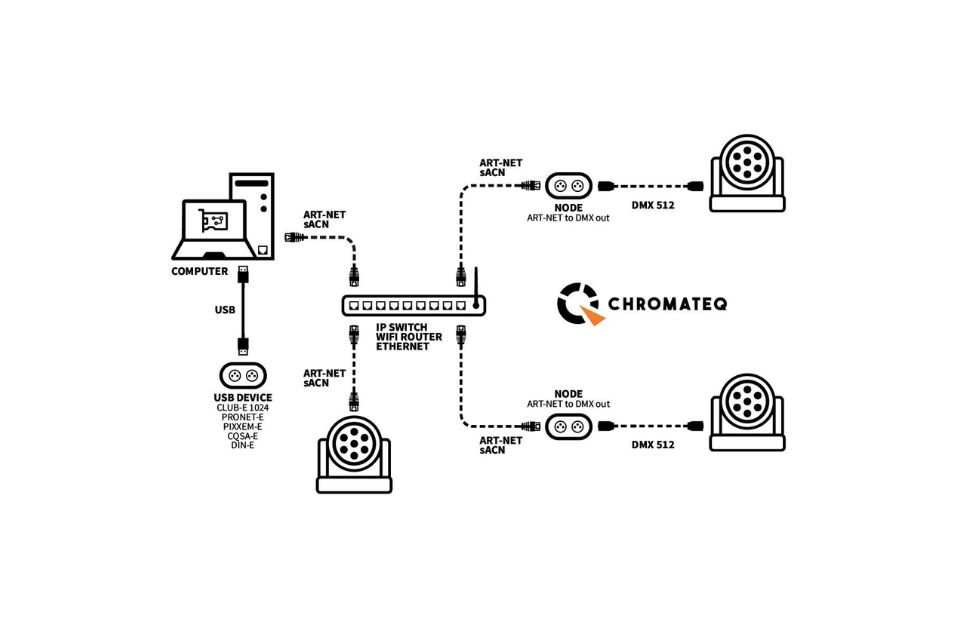Explore the most widely used lighting control protocols including DMX, Art-Net, sACN, and Lighting over IP. Understand how they differ and how each impacts modern stage, architectural, and entertainment lighting systems.
Introduction
Modern lighting systems rely on digital communication protocols that ensure precise control, synchronization, and scalability. As technology evolves, lighting professionals have transitioned from traditional DMX wiring to advanced network-based solutions such as Art-Net, sACN, and Lighting over IP. Understanding the differences between these protocols is crucial for designing efficient and future-ready lighting networks.
DMX - The Industry Standard for Lighting Control
DMX512 (Digital Multiplex) has been the industry standard since the 1980s. It transmits control signals through a serial data link, allowing up to 512 channels per universe. Each channel controls a single parameter, such as brightness, color, or pan/tilt position. Although reliable and simple, DMX is limited by cable length, channel capacity, and lack of network-based scalability.
Advantages of DMX
- Reliable and widely supported across all lighting fixtures and consoles.
- Simple setup with standardized cabling (XLR 5-pin or 3-pin).
- Low latency and consistent real-time response.
Limitations of DMX
- Limited to 512 channels per universe.
- Not IP-based - requires dedicated wiring per line.
- Difficult to monitor or troubleshoot over large-scale installations.
Art-Net - DMX Over Ethernet
Art-Net was developed by Artistic Licence as a way to transmit DMX data over standard Ethernet networks. By encapsulating DMX512 data into UDP packets, Art-Net allows multiple universes of DMX to run over Cat5e/Cat6 cabling. It is ideal for large venues, theme parks, and stage productions that require multiple fixtures with complex configurations.
Advantages of Art-Net
- Supports hundreds of DMX universes via Ethernet.
- Flexible topology (star, tree, or daisy chain) using standard network hardware.
- Open protocol - supported by most lighting consoles and software.
Limitations of Art-Net
- Relies on UDP, which is not inherently reliable for critical data.
- Requires proper IP addressing and traffic management to prevent congestion.
sACN - Streaming ACN for Professional Networks
Streaming Architecture for Control Networks (sACN or E1.31) is an evolution of the ACN protocol defined by ESTA. It uses a more robust transmission model than Art-Net and supports multicast communication, making it ideal for professional installations that demand scalability and redundancy.

Advantages of sACN
- Efficient multicast streaming reduces network load.
- Supports priority levels and merging of multiple control sources.
- Designed for modern IP networks with better reliability and interoperability.
Limitations of sACN
- More complex configuration and network management.
- Not all older fixtures support sACN natively.
Lighting Over IP - The Next Evolution
Lighting over IP represents the integration of control and data transmission over fully IP-based infrastructures. Instead of using traditional DMX universes, fixtures and controllers communicate directly via Ethernet or fiber networks. This approach enables advanced features like remote management, dynamic addressing, and seamless integration with other AV-over-IP systems.
Advantages
- Scalable and flexible architecture suitable for smart buildings and events.
- Allows monitoring and configuration from centralized software interfaces.
- Supports convergence with Audio over IP and Video over IP for unified network management.
Challenges
- Requires high-performance network infrastructure and switches.
- Higher initial cost and training requirements.
Choosing the Right Protocol for Your Application
For small to medium-scale shows or fixed installations, traditional DMX remains reliable and cost-effective. For larger or networked environments, Art-Net and sACN provide superior flexibility, scalability, and monitoring. Meanwhile, Lighting over IP is the direction the industry is heading, particularly for venues investing in next-generation integrated AV systems.
Conclusion
The lighting industry continues to evolve toward IP-based systems that unify control, monitoring, and data distribution. Whether you’re upgrading an existing DMX setup or planning a new installation, understanding how each protocol fits into your workflow is key to ensuring future compatibility and system reliability.